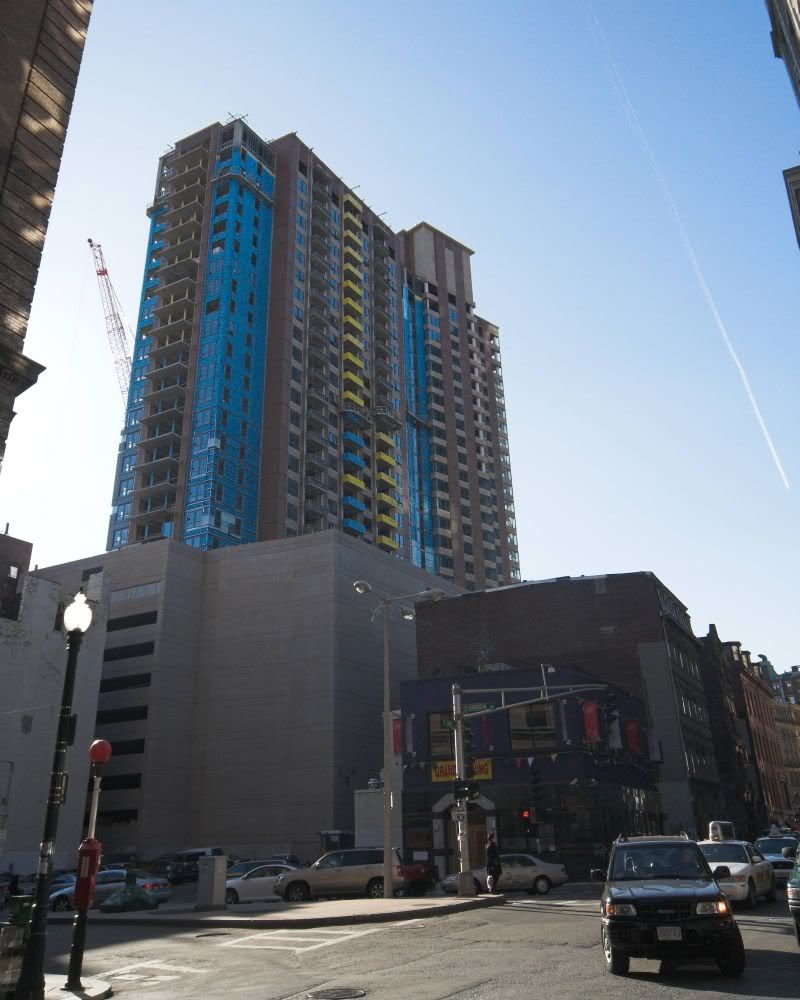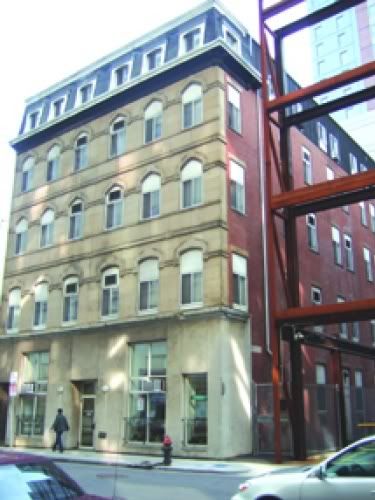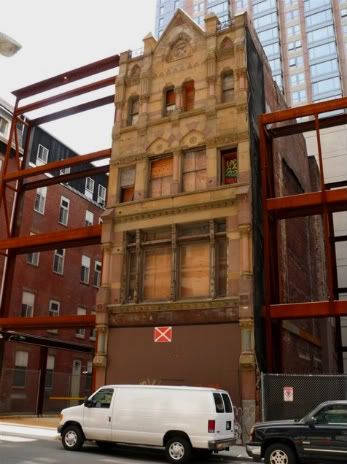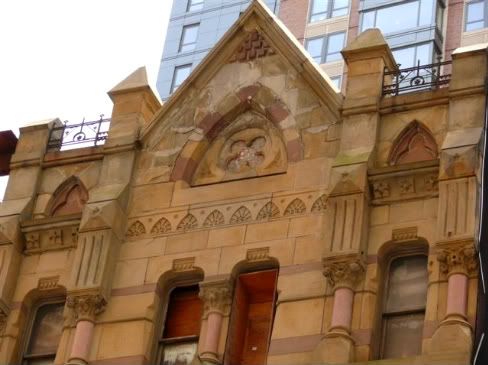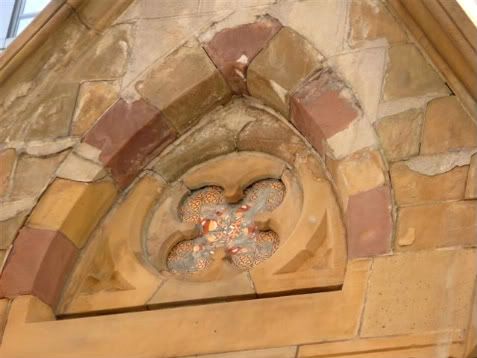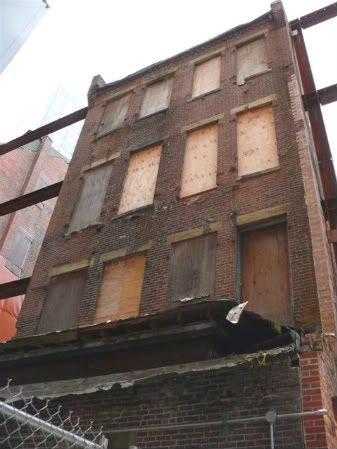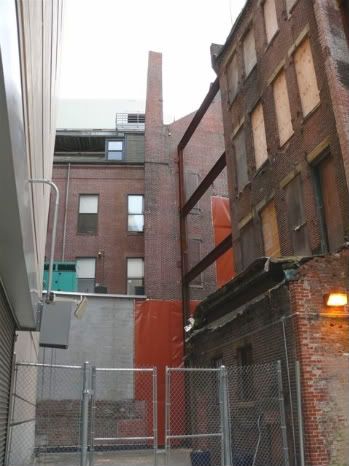Elderly Housing Project Proposed for Liberty Tree Area
Historic Buildings Could Halt Project
Jul 7, 2006
by Adam Smith
What is more valuable: providing additional affordable housing for elderly residents of Chinatown or preserving 19th-century buildings of national historic importance?
This is a question that federal, state, and city officials must soon determine.
The properties in question are at 11 to 31 Essex St. and make up a major section of the Liberty Tree District, an area listed on the National Register of Historic Places and with ties to the "Sons of Liberty" who protested the Stamp Act of 1765. The anchor of the district, the Liberty Tree Building on Washington Street, is not slated for development and has for years been used as the Boston branch of the Massachusetts Registry of Motor Vehicles.
The Liberty Tree District, much of which consists of vacant and already demolished buildings, could dramatically change if a plan by two nonprofit developers of elderly housing succeeds. On Luck Housing Development and Rogerson Communities propose to raze two structures and replace them with an eight-story building that would provide 75 units of low-income housing for elderly and physically handicapped Chinese immigrants. The proposal would greatly expand the 28-unit Hong Lok House, which is within the historic district and owned by On Luck, a division of the Greater Boston Chinese Golden Age Center. The Golden Age Center has provided low-income housing as well as nursing care services for the elderly since the early 1970s.
But building the elderly housing project as planned would destroy nearly all that remains of the Liberty Tree District, which in recent years has been reduced from a six-building cluster to only three buildings and a preserved facade. The project would raze a building at 15 Essex St., which was built in 1875, and the Hong Lok House at 25 Essex St., which dates back to the 1870s. Both buildings are considered examples of high Victorian Gothic architecture.
Attempting to preserve some of the past, Rogerson Communities and On Luck say they would renovate the facades of two buildings, the one at 15 Essex St. and another at 11 Essex Street. The latter building has already been razed but its preserved facade is the only surviving wood-facade of a commercial building in Boston's central business district. The developers said that preserving any of the actual buildings would halt their proposal to build low-income elderly housing because of the cost and design restraints. Just to save the facades, they say, would be "terribly expensive," suggesting the cost could run over $1 million.
Rogerson Communities and On Lok hope to persuade the Department of Housing and Urban Development, the Massachusetts Historical Commission, and the Boston Landmarks Commission to allow the elderly housing proposal to move forward and to sacrifice the buildings. HUD, a federal agency, would have the final say.
Jamie Seagle, president of Rogerson Communities, said that if the developers were forced to preserve all the buildings: "it would kill the project.? He added: ?For Chinatown, waiting lists for elderly housing are everywhere.?
Yet to demolish the buildings would eliminate a part of old Boston where much of old Boston has already been lost. Just around the corner from the project site, several historic buildings once stood on Washington Street but were flattened years ago. Two examples are the Pilgrim Theatre that was built in 1912 by architect Clarence Blackall, designer of the Wang Center, and the Royal Hotel, which dated back to the first half of the 19th century and was within the Liberty Tree District.
So far, the Massachusetts Historical Commission has said nothing publicly about the plan to flatten the buildings, but a letter it sent to the developers stresses the value of the buildings. "Demolition of the majority of 15-17 Essex Street, leaving only the facade intact, along with the demolition of 25-31 Essex Street will have an adverse effect on the Liberty Tree Historic District," wrote the commission's acting director, Brona Simon, in a letter to Seagle.
Ruth Moy, director of On Luck, suggests that she unwittingly inherited some of the restrictions on the historic buildings from another developer, Archstone Smith. Before the elderly housing proposal, On Luck Development had an earlier agreement with Archstone Smith, who was building a 28-story residential tower called Liberty Place (now called Archstone Boston Common). The developer was to give the Hong Lok House 22 new housing units for the elderly. That deal has since soured, leading to the present proposal by On Luck and Rogerson Communities.
When On Luck was promised the 22 units of housing -- touted by the developer and city officials as a public benefit of the 28-story high-rise -- the tower's developer also made a deal with the state to preserve the historic buildings abutting the project site. Under the agreement, Archstone Smith was obligated to renovate 15 Essex St. and the facade of 11 Essex St. in return for razing other structures, the Royal Hotel on Washington Street and a property at 19 Essex St. Hong Lok would not have been affected by the former proposal as the 22 units were to be built next door to the elderly home.
Then the plan to get the 22 units of elderly housing failed to unfold as expected, claims Moy. As the high-rise neared completion, Moy said, it became clear that the 22 units would not be low-cost enough for elderly residents who depend on Social Security as primary income sources. But while the Liberty Place proposal eased through the city's approval process four years ago, the Boston Redevelopment Authority boasted that the units targeted for Hong Lok would be "designated for very low-income households earning between zero and 60% of area median income."
This May, On Luck Development, the Boston Redevelopment Authority, and Archstone Smith devised another plan: Archstone Smith would give three small parcels of land, including the historic building, on Essex Street to On Luck, along with two newly built foundations, and a payment of $500,000 to be matched by the BRA. Archstone Smith did not return a phone call and e-mail requesting information about why the previous deal fell apart. The BRA also did not respond before the deadline for this story.
Moy and Seagle, director of Rogerson Communities, suggested that in a rush decision to accept the new offer, they overlooked the earlier agreement and the protections of the buildings. In addition, Moy, who has run Hong Lok since it opened in 1982, claims she was unaware until recently that the building is listed on the National Register of Historic Places.
"They certainly never told me," she said. A spokesman for the Massachusetts Historical Commission, however, said that landowners are notified if their property is listed on state or national registers of historic places. Also, Archstone Smith?s promise to renovate the properties has been publicly available for several years.
Moy and Seagle say they're moving forward despite the risk that government officials may demand the historic buildings be preserved. The two also say they've already begun fundraising for the $22 million elderly housing project.
The need for housing for Chinese immigrants over age 65 is widely recognized in Chinatown, and a recent study by UMass Boston?s Institute for Asian American Studies shows that a majority of Chinese elderly lack English proficiency.
Moy is well known for providing elderly services. Hong Lok opened in the early 1980s when the area was overrun by porn theaters and drunks.
"It was a very depressing area,? said Moy. She said that the remaining buildings on Essex Street are deteriorating.
When asked how she felt about On Luck?s deals with Archstone Smith, she said: "I think they get what they want."
But when Liberty Place was proposed, Moy was a strong supporter of the developer's tower. It would lead to the expansion of Hong Lok and removed adult entertainment businesses from the area. She invited Hong Lok's elderly residents to back the high-rise during city development hearings, though many others protested the proposal because they felt it was out of character with Chinatown.
---------
BACKGROUND:
Who will decide if the historic buildings stay?
The U.S. Department of Housing and Urban Development will ultimately decide whether the elderly housing project can replace the historic buildings. The Massachusetts Historical Commission will comment on the matter to HUD and provide consultation, but will not make the actual decision. No dates have been set for when HUD will take on the matter. HUD is involved because the Essex Street properties that would be demolished are listed on the National Register of Historic Places and because the proposed elderly housing project seeks federal subsidies.
Liberty Tree
The corner of Essex and Washington Streets once housed the Liberty Tavern and an elm called the Liberty Tree. It is said that the "Sons of Liberty" who protested the Stamp Act in 1765 often gathered at the tree and tavern
Later, commercial buildings and hotels were constructed on the corner. Architecturally, the structures represent the change from Greek revival to Italianate style and contain examples of high Victorian Gothic commercial architecture. If the elderly housing project moves ahead as planned, only one building and two facades would remain in what was once the six-building Liberty Tree District.
(Source: Massachusetts Historical Commission)
Hong Lok House
The Greater Boston Chinese Golden Age Center started in 1971 to help elderly Chinese immigrants, who lack English proficiency. After first offering elderly services from a building on Harrison Avenue, the Golden Age Center expanded to run elderly housing and programs out of three locations the Hong Lok House; Quincy Tower, and the Brighton House. On Luck Development, a division of the Golden Age Center that runs Hong Lok House at 25-31 Essex Street, now wants to expand the center's elderly housing. The 28-unit Hong Lok House, along with several other nearby properties on Essex Street, would be demolished and replaced by a 75-unit, eight-story building.

Link
Historic Buildings Could Halt Project
Jul 7, 2006
by Adam Smith
What is more valuable: providing additional affordable housing for elderly residents of Chinatown or preserving 19th-century buildings of national historic importance?
This is a question that federal, state, and city officials must soon determine.
The properties in question are at 11 to 31 Essex St. and make up a major section of the Liberty Tree District, an area listed on the National Register of Historic Places and with ties to the "Sons of Liberty" who protested the Stamp Act of 1765. The anchor of the district, the Liberty Tree Building on Washington Street, is not slated for development and has for years been used as the Boston branch of the Massachusetts Registry of Motor Vehicles.
The Liberty Tree District, much of which consists of vacant and already demolished buildings, could dramatically change if a plan by two nonprofit developers of elderly housing succeeds. On Luck Housing Development and Rogerson Communities propose to raze two structures and replace them with an eight-story building that would provide 75 units of low-income housing for elderly and physically handicapped Chinese immigrants. The proposal would greatly expand the 28-unit Hong Lok House, which is within the historic district and owned by On Luck, a division of the Greater Boston Chinese Golden Age Center. The Golden Age Center has provided low-income housing as well as nursing care services for the elderly since the early 1970s.
But building the elderly housing project as planned would destroy nearly all that remains of the Liberty Tree District, which in recent years has been reduced from a six-building cluster to only three buildings and a preserved facade. The project would raze a building at 15 Essex St., which was built in 1875, and the Hong Lok House at 25 Essex St., which dates back to the 1870s. Both buildings are considered examples of high Victorian Gothic architecture.
Attempting to preserve some of the past, Rogerson Communities and On Luck say they would renovate the facades of two buildings, the one at 15 Essex St. and another at 11 Essex Street. The latter building has already been razed but its preserved facade is the only surviving wood-facade of a commercial building in Boston's central business district. The developers said that preserving any of the actual buildings would halt their proposal to build low-income elderly housing because of the cost and design restraints. Just to save the facades, they say, would be "terribly expensive," suggesting the cost could run over $1 million.
Rogerson Communities and On Lok hope to persuade the Department of Housing and Urban Development, the Massachusetts Historical Commission, and the Boston Landmarks Commission to allow the elderly housing proposal to move forward and to sacrifice the buildings. HUD, a federal agency, would have the final say.
Jamie Seagle, president of Rogerson Communities, said that if the developers were forced to preserve all the buildings: "it would kill the project.? He added: ?For Chinatown, waiting lists for elderly housing are everywhere.?
Yet to demolish the buildings would eliminate a part of old Boston where much of old Boston has already been lost. Just around the corner from the project site, several historic buildings once stood on Washington Street but were flattened years ago. Two examples are the Pilgrim Theatre that was built in 1912 by architect Clarence Blackall, designer of the Wang Center, and the Royal Hotel, which dated back to the first half of the 19th century and was within the Liberty Tree District.
So far, the Massachusetts Historical Commission has said nothing publicly about the plan to flatten the buildings, but a letter it sent to the developers stresses the value of the buildings. "Demolition of the majority of 15-17 Essex Street, leaving only the facade intact, along with the demolition of 25-31 Essex Street will have an adverse effect on the Liberty Tree Historic District," wrote the commission's acting director, Brona Simon, in a letter to Seagle.
Ruth Moy, director of On Luck, suggests that she unwittingly inherited some of the restrictions on the historic buildings from another developer, Archstone Smith. Before the elderly housing proposal, On Luck Development had an earlier agreement with Archstone Smith, who was building a 28-story residential tower called Liberty Place (now called Archstone Boston Common). The developer was to give the Hong Lok House 22 new housing units for the elderly. That deal has since soured, leading to the present proposal by On Luck and Rogerson Communities.
When On Luck was promised the 22 units of housing -- touted by the developer and city officials as a public benefit of the 28-story high-rise -- the tower's developer also made a deal with the state to preserve the historic buildings abutting the project site. Under the agreement, Archstone Smith was obligated to renovate 15 Essex St. and the facade of 11 Essex St. in return for razing other structures, the Royal Hotel on Washington Street and a property at 19 Essex St. Hong Lok would not have been affected by the former proposal as the 22 units were to be built next door to the elderly home.
Then the plan to get the 22 units of elderly housing failed to unfold as expected, claims Moy. As the high-rise neared completion, Moy said, it became clear that the 22 units would not be low-cost enough for elderly residents who depend on Social Security as primary income sources. But while the Liberty Place proposal eased through the city's approval process four years ago, the Boston Redevelopment Authority boasted that the units targeted for Hong Lok would be "designated for very low-income households earning between zero and 60% of area median income."
This May, On Luck Development, the Boston Redevelopment Authority, and Archstone Smith devised another plan: Archstone Smith would give three small parcels of land, including the historic building, on Essex Street to On Luck, along with two newly built foundations, and a payment of $500,000 to be matched by the BRA. Archstone Smith did not return a phone call and e-mail requesting information about why the previous deal fell apart. The BRA also did not respond before the deadline for this story.
Moy and Seagle, director of Rogerson Communities, suggested that in a rush decision to accept the new offer, they overlooked the earlier agreement and the protections of the buildings. In addition, Moy, who has run Hong Lok since it opened in 1982, claims she was unaware until recently that the building is listed on the National Register of Historic Places.
"They certainly never told me," she said. A spokesman for the Massachusetts Historical Commission, however, said that landowners are notified if their property is listed on state or national registers of historic places. Also, Archstone Smith?s promise to renovate the properties has been publicly available for several years.
Moy and Seagle say they're moving forward despite the risk that government officials may demand the historic buildings be preserved. The two also say they've already begun fundraising for the $22 million elderly housing project.
The need for housing for Chinese immigrants over age 65 is widely recognized in Chinatown, and a recent study by UMass Boston?s Institute for Asian American Studies shows that a majority of Chinese elderly lack English proficiency.
Moy is well known for providing elderly services. Hong Lok opened in the early 1980s when the area was overrun by porn theaters and drunks.
"It was a very depressing area,? said Moy. She said that the remaining buildings on Essex Street are deteriorating.
When asked how she felt about On Luck?s deals with Archstone Smith, she said: "I think they get what they want."
But when Liberty Place was proposed, Moy was a strong supporter of the developer's tower. It would lead to the expansion of Hong Lok and removed adult entertainment businesses from the area. She invited Hong Lok's elderly residents to back the high-rise during city development hearings, though many others protested the proposal because they felt it was out of character with Chinatown.
---------
BACKGROUND:
Who will decide if the historic buildings stay?
The U.S. Department of Housing and Urban Development will ultimately decide whether the elderly housing project can replace the historic buildings. The Massachusetts Historical Commission will comment on the matter to HUD and provide consultation, but will not make the actual decision. No dates have been set for when HUD will take on the matter. HUD is involved because the Essex Street properties that would be demolished are listed on the National Register of Historic Places and because the proposed elderly housing project seeks federal subsidies.
Liberty Tree
The corner of Essex and Washington Streets once housed the Liberty Tavern and an elm called the Liberty Tree. It is said that the "Sons of Liberty" who protested the Stamp Act in 1765 often gathered at the tree and tavern
Later, commercial buildings and hotels were constructed on the corner. Architecturally, the structures represent the change from Greek revival to Italianate style and contain examples of high Victorian Gothic commercial architecture. If the elderly housing project moves ahead as planned, only one building and two facades would remain in what was once the six-building Liberty Tree District.
(Source: Massachusetts Historical Commission)
Hong Lok House
The Greater Boston Chinese Golden Age Center started in 1971 to help elderly Chinese immigrants, who lack English proficiency. After first offering elderly services from a building on Harrison Avenue, the Golden Age Center expanded to run elderly housing and programs out of three locations the Hong Lok House; Quincy Tower, and the Brighton House. On Luck Development, a division of the Golden Age Center that runs Hong Lok House at 25-31 Essex Street, now wants to expand the center's elderly housing. The 28-unit Hong Lok House, along with several other nearby properties on Essex Street, would be demolished and replaced by a 75-unit, eight-story building.

Link


